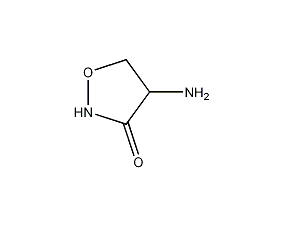D-cycloserine


Structural formula
| Business number | 04AL |
|---|---|
| Molecular formula | C3H6N2O2 |
| Molecular weight | 102.09 |
| label |
levocycloserine, cycloserine, L-4-amino-3-isoxazolidinone, L-cycloserine, D-4-isoxazolone, Phyllomycin PA-94, Oromycin, (l)-3-isoxazolidinon, (s)-3-isoxazolidinon, H-CYCLOSERINE, L-CYCLOSERINE, L-4-AMINO-3-ISOOXAZOLIDINONE, L-4-AMINO-3-ISOXALOLIDINONE, L-4-AMINO-3-ISOXAZOLIDINONE, S(-)-4-AMINO-3-ISOXAZOLIDINONE |
Numbering system
CAS number:339-72-0
MDL number:MFCD0064324
EINECS number:206-427-0
RTECS number:NY2976000
BRN number:80799
PubChem number:24278296
Physical property data
一 , physical property data
Traits :Not available
Density (g/mL,25/4℃): Not available
Relative Vapor density (g/mL, air=1):Not available
Melting point (ºC): 147
Boiling point (ºC, normal pressure): Not available
Boiling point (ºC, 5.2kPa): Not available
Refraction Rate: Not available
Flash Point (ºC): Not available
Optical rotation (º): Not available
Spontaneous combustion Point or ignition temperature (ºC): Not available
Steam Pressure (kPa, 25ºC): Not available
saturated Vapor pressure (kPa, 60ºC): Not available
Burn Heat (KJ/mol):Not available
Critical Temperature (ºC): Not available
Critical Pressure (KPa): Not available
oil and water Log value of the (octanol/water) partition coefficient:Not available
Explosion Upper limit (%, V/V): Not available
Lower explosion limit (%,V/V): Not available
Dissolve Properties: Not available
Toxicological data
Two , Toxicological data:
Acute Toxicity:Not available .
Ecological data
Three , Ecological data:
1 ,Other harmful effects: This substance may be harmful to the environment, and special treatment should be given to water bodies. Notice.
Molecular structure data
1. Molar refractive index: 22.47
2. Molar Volume (m3/mol):79.8
3. isotonic specific volume (90.2K):201.9
4. Surface Tension (dyne/cm):40.8
5. Polarizability(10-24cm3): 8.90
Compute chemical data
1. Reference value for hydrophobic parameter calculation (XlogP): -1.5
2. Number of hydrogen bond donors: 2
3. Number of hydrogen bond acceptors: 3
4. Number of rotatable chemical bonds: 0
5. Number of tautomers: 5
6. Topological molecule polar surface area 64.4
7. Number of heavy atoms: 7
8. Surface charge: 0
9. Complexity: 92.9
10. Number of isotope atoms: 0
11. Determine the number of atomic stereocenters: 1
12. Uncertain number of atomic stereocenters: 0
13. Determine the number of chemical bond stereocenters: 0
14. Number of uncertain chemical bond stereocenters: 0
15. Number of covalent bond units: 1
Properties and stability
None yet
Storage method
None yet
Synthesis method
None yet
Purpose
None yet
